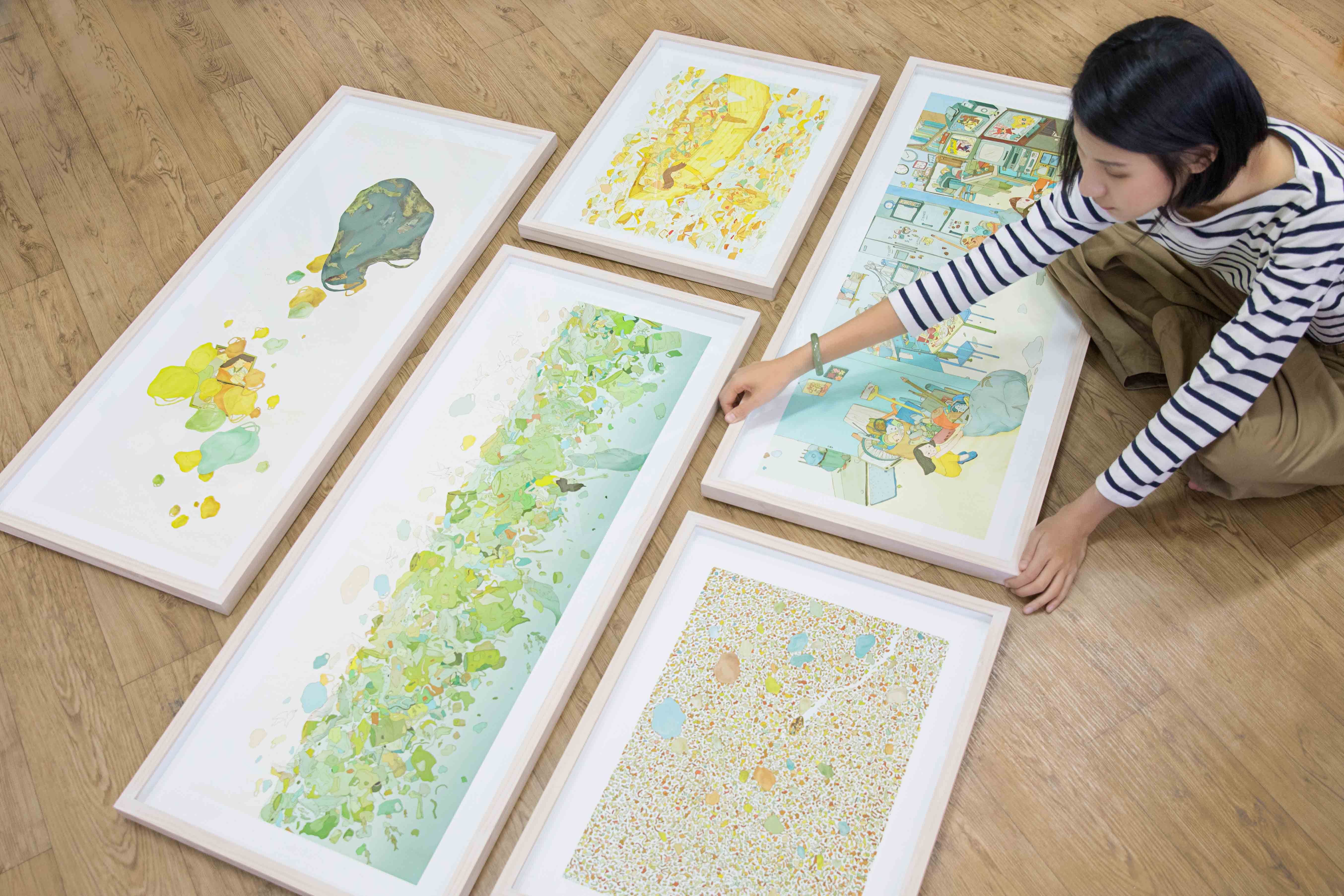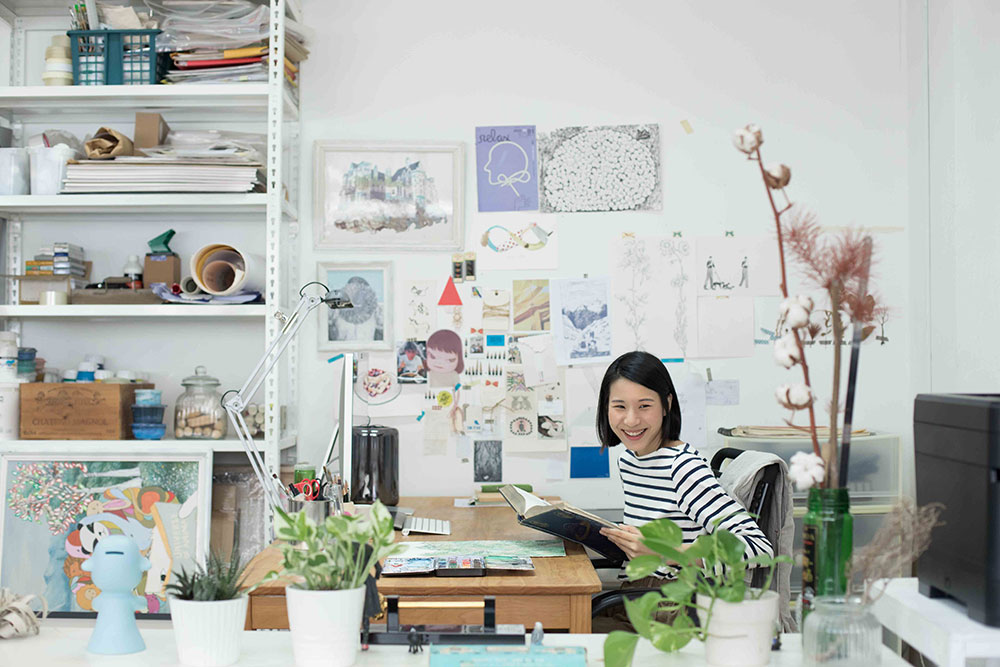Join other trail-blazing young adults in getting monthly career & financial tips, written by those who have succeeded before.
FRANK by OCBC x Messymsxi — A Natural Effort
In a slum in India, knee-deep in 400kg of plastic waste, surrounded by the choking smell of burning PVC—Zi Xi's has been to some interesting places, all as a result of her passion for the environment. As the daughter of a Chinese painter, illustration came naturally to Zi Xi, although it was never a profession she thought she’d end up in.
She graduated in Visual Communication from Temasek Polytechnic, but it took a stint in an agency for her to realise that her true interest lay in illustration. She went on to pursue further studies in the subject at the esteemed Central Saint Martins in London, which counts, among others, Lucian Freud, M.I.A., and Alexander McQueen as its famous alumni. It was there that she developed her now-distinct style, and where she also started a series of works that addresses the state of the environment today.
Although she’s perhaps better known for her whimsical illustrations (and by her moniker Messymsxi), it was her work titled Plastic Ocean—first created for the Singapore Art Museum in 2016, and then recreated for the Sassoon Dock Art Project in Mumbai last year—that caught our eye: a perfect embodiment of our concerns about the impact of waste in our world. We went on to find that Zi Xi also practises what she preaches: by choosing to avoid using single-use plastics as much as she can, and making more conscious consumption choices, she’s doing her part to save the environment. Zi Xi is also working on two different artworks for our FRANK cards, adapted from a series of work titled Green Is Running Out, about the significance of living a greener way of life in an ever-growing urban landscape, which, we hope, will be a handy, poignant reminder about our relationship with nature. In her cosy, light-filled studio—an unexpected find in an old factory building in Tai Seng—we spoke to the artist about her work, her struggles as a student in London, and some ways we can all chip in to make our oceans full of life instead of plastic.
1. How did you become interested in illustration?
I think it all started when I was studying in Temasek Polytechnic—I didn’t do well for some classes, like typography or branding, but illustration was something I was interested in. Drawing was a way for me to express my ideas; I’m definitely not someone who would write, and I find it difficult to find the words to speak about my feelings, so for me illustration is a way of communication. But at the same time I try to present it in a lighter tone and manner so people don’t get put off. At first glance, if you don’t look closely, my work might look cheerful or happy, for lack of a better word, but there’s actually a darker, more unsettling message. I’ve now been doing this for eight years.
2. When did your concern about the environment begin?
I’m drawn to issues that I feel are meaningful to communicate about—I’ve also worked on drug addictions and eating disorders, the latter of which was something I personally went through. My Final Year Project in Temasek Polytechnic, titled Teri’s Most Beautifuls (2004), was inspired by Easter Island, and how the inhabitants wiped out all its natural resources. I saw it as a parallel to the way we’re depleting our earth in such a reckless manner. But it wasn’t till I started studying in London that I read about the Great Pacific Garbage Patch, and then I went a year without shopping, in a bid to reduce my own consumption. That also inspired me to create An Effort Most Futile (2008) and Plastic Ocean (2016). Working on Plastic Ocean was a revelation of my own living habits; it gave me the conviction to change my mindset and actions.
3. The artworks we’ve photographed today are from your series, An Effort Most Futile. Can you tell us more about it?
The series started in 2008, when I was still in the United Kingdom (UK). I first had the idea for creating the artworks when I read a news article about the Great Pacific Garbage Patch, which is a large area of the Pacific Ocean covered by floating plastic trash, about the size of an island. I was alarmed and upset that people would carelessly dump their waste in the ocean, so that kickstarted the series.
4. We’d love to hear more about Plastic Ocean, and the process of creating it. How did the project come about?
The Singapore Art Museum contacted me after they’d seen Heavy Hands, Heavy Head, the 143-metre-long installation I created for my exhibition at The Substation. When they saw that I was able to venture into tactile works, they asked me to propose something for their exhibition Over the Ocean, Under the Sea. When I saw the brief, I thought about translating one of the illustrations from An Effort Most Futile into a 3D installation. I thought it would be impactful if people could experience what life was like for fish, living underwater with so much trash around them, having the trash become part of their habitat and them suffering the consequences of our actions. I used 20,000 pieces of waste for Plastic Ocean.
5. What was it like going from 2D illustration to a project on such a massive scale?
It was quite a challenge. There were a lot of factors to consider, like the size of room, quantity of plastics needed, instilling a standard process for stringing of plastics, room set-up in terms of lighting, mirrors, and ceiling mesh, etc. Any mistakes in the measurements, methodology or my instructions would have meant setting us back in terms of time. As the sole receiver of all the trash, and working on it and witnessing the sheer amount that was produced, the feeling was overwhelming. It took about six months to produce, two of which were spent with 10 people working on it every day, cleaning and washing the trash, and stringing plastics. Sorting through it really made me question why all this was necessary, so working on that project made me and my team of volunteers think about our impact on the environment.
6. What did you learn during that process of recreating Plastic Ocean in Mumbai?
We went to Mumbai to collect waste as part of the project, and that was interesting because in India nothing goes to waste, and everything can be recycled. There are these recycling centres located in the slums, and the conditions there are harsh—when we were there, we saw workers crushing collected plastics and melting them down. We knew that they might not actually care about the environment, but were working in recycling just to make a living. India is actually one of the biggest contributors to recycling, because they purchase plastic waste from countries like Singapore and China, and seeing the vast amounts of waste gathered there made me question the way we consume. Even recycling has negative by-products, such as the toxic fumes from the burning of waste.
7. You studied at Central Saint Martins (CSM) in London, where you received your degree in Graphic Design (Illustration Major). Can you tell us more about your time in London?
Living in London transformed my life because it was so different from Singapore. Singapore is so orderly and systematic, but I liked how chaotic London was. The drastic change in environment awakened my senses. Being there also informed me on news and issues, because people hand out free copies of newspapers on the streets and subways so it’s normal to grab one when you’re en route to school or work. I started reading a lot about local news, which exposed me to different issues. Also, their documentaries are very informative, so that got me into watching more YouTube videos and shows on BBC Channel 4.
8. How did you manage your finances while you were there?
The exchange rate then was very steep—maybe £1 to S$3.10. A small coffee from Starbucks would cost S$12 or S$15, which made coffee almost a luxury. I had to quickly figure out what things were necessities for me. My housemates and I would go to weekend markets, where things were sold in bulk and you could buy a basket of apples for £1. We would also walk around Chinatown to figure out the cheapest places to dine at. Student life for me was very much about learning to be thrifty, because I never had to save for rainy days when I was in Singapore—my parents are generous with money. But in London I learnt to count my pennies.
9. We think of freelancers as having irregular incomes—how true is this, and how do you manage this?
Very true, especially for my first two years, because I did a lot of pro bono work. One belief I’ve held since my college days is that any work that I do, be it pro bono or for a client project, should be good enough to include in my portfolio. So I started building up my portfolio in my college days, and it was only after my first two years, when I had become comfortable, that I started to get commercial jobs. I don’t actively look for jobs, I just hope that whatever I’ve done is good enough to bring me new opportunities.
For me, irregular income just means being able to spend more if I earn more, and having to spend less if I earn less—it’s about managing my spending. I consider myself quite a spoilt kid, but after I came back from the UK I stopped taking an allowance from my parents, and I managed whatever income I was receiving. Living in London made me get used to being thrifty, and even though I was on scholarship for the duration of my studies, I was travelling quite a lot, and my parents had to spend quite a bit on my accommodation and daily expenses. When I came back to Singapore, I decided to put a stop to taking money from my parents and to start managing my income and expenses, and making decisions like having my meals at hawker centres rather than at cafés or restaurants.
10. Why did you choose to freelance instead of joining a branding agency or graphic design studio?
I joined an agency right after I graduated from Temasek Polytechnic, but it didn’t work out. As a designer, I wasn’t the best fit for what they were doing, and I wasn’t suited to the nature of the work. I prefer to execute creative work based on my own ideas, and having to work based on strict instruction was very dry to me. That was my first full-time job after I graduated, and I left that experience with the realisation that design didn’t suit me as much as illustration. After that, I went to study at CSM.
11. You currently share your studio space with a design and branding company. Do you have any plans to have your own space one day?
I used to dream of having a garage space and transforming it into a studio, but that idea would be more practical in Europe or the United States where space is more abundant. In Singapore, where space is a luxury, I’m very thankful that I have this studio. At the same time, I have a flat on the way, so I have plans to convert one of the rooms into a studio. That way, I can save on rental and put the sum into my mortgage.
12. How do you negotiate commissions/projects/collaborations?
It comes with a few years of experience. Quoting clients for projects is sometimes a hit and miss situation, and over time you’ll learn to assess what kind of budgets clients have. Sometimes I find it’s easier to directly ask them how much their budget is, rather than trying to second guess. It also helps to find out from more experienced designers and illustrators. However, I try not to see the value of my work in terms of its chances of being sold—I try to create work that I enjoy, but it’s a bonus if I manage to make a living from it. Of course there’s some give and take—there may be jobs that I do not enjoy, but which I take on because they bring in income. At the end of the day, you still have to careful that the bread and butter jobs do not drain you emotionally, and that they are something you’d be proud to include in your portfolio.
13. Was there a moment where your attitude towards money, investing, saving, and protecting changed?
The importance of having savings dawned on me when I returned from the UK. My husband’s sister and parents all work in banks, so when I first met him, I didn’t have any insurance or savings, which was appalling to him, because I was already 27 years old. That’s when I started looking into how to start saving and having enough for major events in life. Also, planning for a flat would mean needing to save for renovation and mortgage, so that was a ‘grown-up’ moment for me, having to make financial decisions. I invest a little because my husband’s father is a remisier.
14. People often perceive green and healthy lifestyles to be expensive to maintain—is this true?
It hasn’t become more expensive for me. When I tell grocers at the market that I don’t need a plastic bag, and to just put my purchases in my reusable bag, they actually give me more vegetables for free. Sometimes, when I’m getting just one or two items because I only want to buy what I need, they’re happy to just give me the items. I find that when you share with people where you’re coming from, they are more receptive than you expect. Even when I go to NTUC, where they have an initiative to give you a discount for bringing your own bags, the cashiers thank me when I put my purchases in my reusable bags. For me, it feels good when I know I’m doing the right thing.
15. What are some other ways in which being more conscious about your own consumption has made financial sense in the long term?
It starts with being conscious about our buying culture. I read a book called Goodbye, Things by Fumio Sasaki which talks about how people own too many belongings, and how these belongings often do not serve a purpose, but rather are just decorative. Sasaki was originally a hoarder, but as he started to reduce his belongings, he was set free from the mindset of our possessions validating our identity and status. After reading that book and Marie Kondo’s The Life-Changing Magic Of Tidying Up, I started clearing away things I liked but didn’t necessarily need, and it made me re-examine my lifestyle and the things I owned. I used to shop online for clothes a lot, but since reading the book last December I haven’t shopped online at all.
16. What are your thoughts on how it now seems to be a trendy thing to be ‘green’/go vegan for the environment?
The trend to be green now might be due to influence from the media, and people are now a lot more aware of the dire situations and consequences of various types of pollution due to our modern lifestyles. However, I feel like adopting a green lifestyle has to start with something you are genuinely concerned about. It’s second nature to me now to bring a tote bag with me or a reusable cup when I buy drinks because I don’t want to contribute to more plastic waste. It seems like a hassle to many people because they’ve been conditioned to rely on plastic products for convenience, but it becomes easier if you’re committed to making a change in your lifestyle because you want to reduce waste or be green.
17. What are some steps youths can take towards conscious consumption and understanding their impact on the environment?
I’m a documentary junkie, so I watch a lot about fast fashion. That’s actually led me to stop shopping at brands that I know that exploit their workers. The world is very big, and we’re quite sheltered in Singapore. If you’re aware of the amount of trash that exists in the oceans and landfills, you’d question whether all our consumption is necessary. If you cannot reduce the amount of trash you produce, the next best thing to do is to recycle. I learned from a lady named Bea Johnson who practices five ‘Rs’: Refuse (to take/use plastic products), Reduce, Reuse, Recycle and Rot (have a compost bin for food waste or any organic matter). For me, conscious consumption is choosing not to use a plastic cup when I takeaway drinks, even though it’s inconvenient. I also bring my own tumblers, reusable bags, or metal straws. It sounds like a lot of effort, but they don’t add much weight to my bag. Every little bit helps; refusing to take one plastic straw a day makes for 365 straws saved a year, and if you multiply that by the number of people who are making that decision, that adds up.
18. What are you working on right now, or a project you would love to undertake?
Aside from the card designs I’m working on for FRANK by OCBC, I’m finishing a series of privately commissioned paintings, and I’m also working on a project with a watch brand. A project I’d like to work on is to design carpets, wallpaper, or other environmental graphics for a hotel, mall, or airport. Every time I visit the airport, I feel like the carpet can be better designed, and that applies to the surroundings in the mall as well, be it the wallpaper or the tiles.
19. Something interesting about yourself, off the top of your head:
I have about 100 plants at home. My favourite is the Euphorbia francoisii. I have three of them, one of which blooms every day, and each flower contains even more tiny flowers. It made me realise nature is full of surprises.
Click here to view more sustainable hacks and content.

















